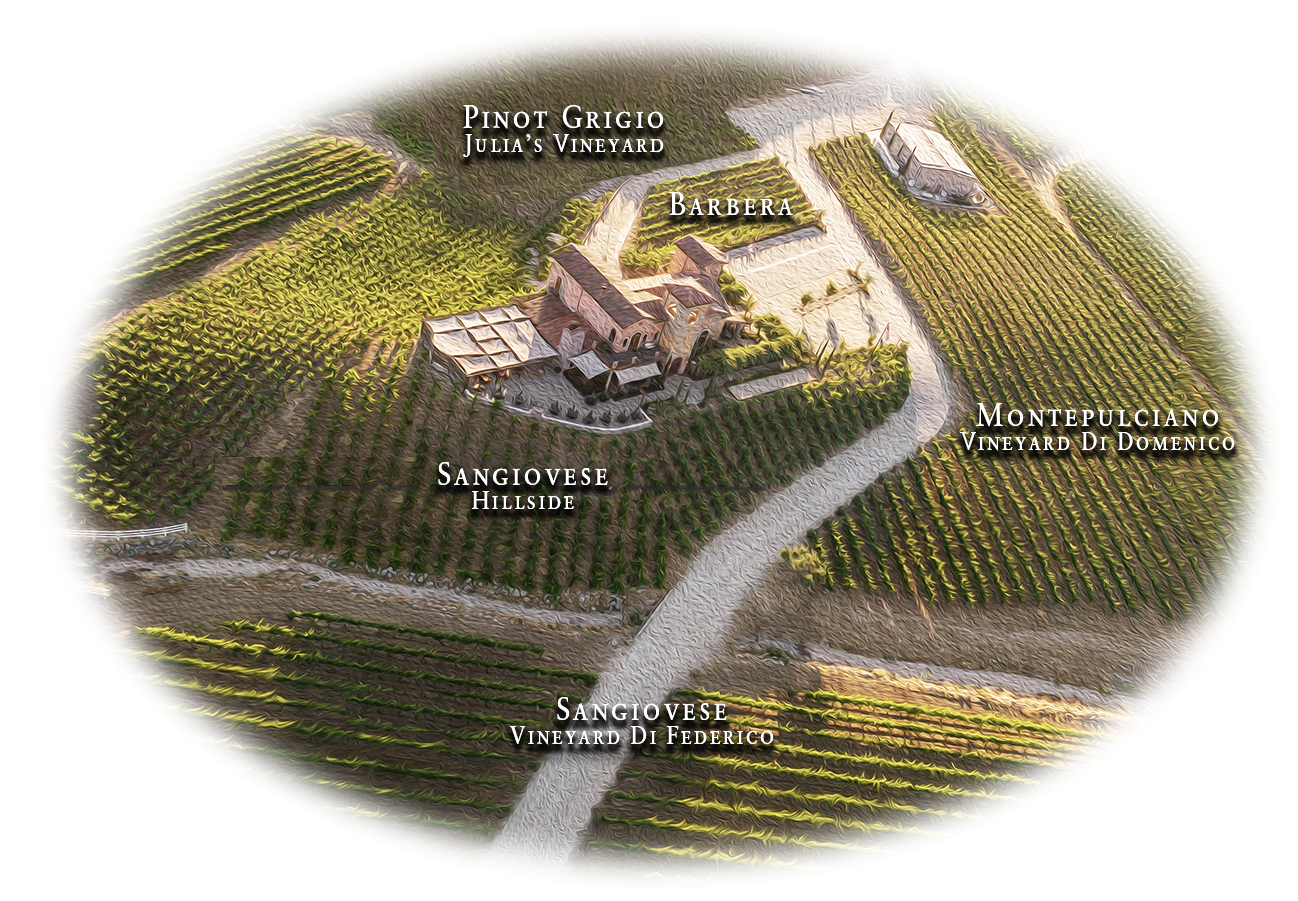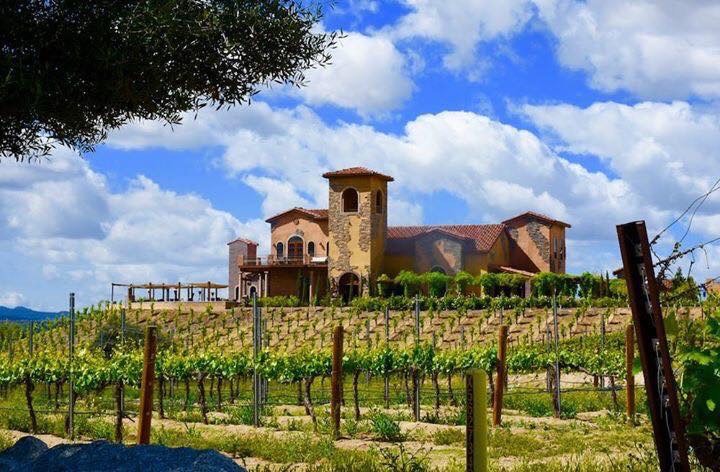Our Estate
Robert Renzoni Vineyards is comprised of 12 acres in the Temecula Valley that is naturally suited to grape growing. Ten of the vineyard’s acres are planted to the classic Bordeaux & Italian grape varieties in 6 vineyard blocks:
MONTEPULCIANO Clone 8 & 4 (3 acres)
PINOT GRIGIO Clone 4 (3 acres)
SANGIOVESE Clone 5 (4 acres)
BARBERA Clone 3 (1 acre)

Robert Renzoni Vineyards is a remarkable estate, nestled in the heart of the Temecula Valley. It was one of the last great undeveloped properties in Temecula and has all the characteristics of a great wine estate: rolling hills, different microclimates, three distinct soil types and multiple elevations. The property provides an ideal growing climate as well as scenic vistas from which to enjoy the beautiful landscape that is Temecula.
The property was purchased in 2006. Although a Cabernet Sauvignon vineyard existed on a portion of the estate, the majority of the property was virgin soil. This soil was ideal for the planting of several varietals, including Pinot Grigio, Barbera, and Sangiovese. Indeed, it was the diversity of the land that convinced Robert and his family of the potential for the property to become a truly great wine estate.
Surrounded by soaring mountains, the picturesque estate includes beautiful olive trees that add to the lush landscape. The vineyards are set among rolling hills and along a creek that flows through the lower vineyard and a smaller creek that flows through the picnic grounds at the rear of the property. Join us in the afternoon and experience the beautiful sea breezes that sweep through the Rainbow Gap and across the estate. Few vineyards provide such a picturesque setting.

Developing Our Vineyards
Starting with uncultivated land, allowed Robert to custom design the vineyard’s arrangements. In each specific soil type and microclimate we applied exacting aspects of vineyard innovation such as terrace selection, soil preparation, density of planting, trellis systems and selection of appropriate rootstock and clones.
The most significant lesson we learned while cultivating our vineyards is the need to keep the soil alive with an assortment of plant life. The Winery manages pests with organic materials, cover crops and other innovative and environmentally-friendly practices, and only when required. From its very inception, the estate has been maintained with a strict criterion of care for the plants, soil and the environment.
We believe one of the influential features that makes our Temecula winery and vineyard special is that the vines we raised are the original vines planted in our soil.
Vineyard Blocks
Planted in 1998, Cabernet Sauvignon were the first plantings put into our twelve acre estate. In 2007, we expanded to an additional four acres of Brunello Sangiovese, three acres of Pinot Grigio, and 1 acre of Barbera. The soil is decomposed granite and sandy loam.
Vineyard di Domenico
Planted primarily to Clone 8, Cabernet Sauvignon (three acres), previous owners planted this vineyard in 1998 and we purchased it in 2006. In 2007, we implemented our own farming practices consistent with our new plantings. The rich sandy soil will produce what we expect to be exquisite vintages for years to come.
Vineyard di Federico
Comprised of four acres of Brunello cloned Sangiovese, these grapevines are essentially “off the boat” from Tuscany Italy. If Barolo is the King of Italian grape varietals, the Brunello is certainly the Queen. Produced on our estate, Brunello becomes delicate, fragrant and sometimes mysterious.
Julia’s Vineyard
Robert planted this 3-acre vineyard with Pinot Grigio, clone 4. The well-drained soil is decomposed granite and sandy loam, and produces grapes with the intense varietal character, true to its Northern Italian roots.
Rootstock Diversity
Each of the vineyard blocks is carefully matched to a specific rootstock best suited for the soil type found in the block. The benefits of careful rootstock selection include better vigor control, disease resistance and drought tolerance. At our Temecula winery, vineyard management includes continuously re-evaluating available rootstocks and block improvement and on-going replanting.
Trellising
Our vineyards are almost entirely planted using a unilateral cordon with vertical trellising. This allows us to manage the canopy for maximum balance, good light penetration and the proper ratio of leaves to berries.
Awards & Recognition
Publications
Awards
Varietals
Vineyard di Domenico
Planted primarily to Clone 8, Cabernet Sauvignon (3 acres), previous owners planted this vineyard in 1998 and we purchased it in 2006. In 2007, we implemented our own farming practices consistent with our new plantings. The rich sandy soil will produce what we expect to be exquisite vintages for years to come.
Vineyard di Federico
Comprised of four acres of Sangiovese, these grapevines are essentially “off the boat” from Tuscany, Italy. Consisting of 2 distinctly diverse blocks with different sun exposure, trellising system, spacing, slope and soil. Makes for a dynamic, complex expression of this estate grown Sangiovese.
Vineyard di Romeo
In 2014, we planted a ¼ acre of Barbera, clone 3. This vineyard produces exceptionally superb fruit with intense depth therefore we designate it for our Riserva wines. Because we hold this vineyard in such high regard, our team meticulously hand picks every flawless cluster that makes up each vintage. In 2019 we grafted another ¾ acre of Barbera onto our hillside.
Julia’s Vineyard
Rootstock Diversity
Each of the vineyard blocks is carefully matched to a specific rootstock best suited for the soil type found in the block. The benefits of careful rootstock selection include better vigor control, disease resistance and drought tolerance. At our Temecula winery, vineyard management includes continuously re-evaluating available rootstocks and block improvement and on-going replanting.
Trellising
Our vineyards are almost entirely planted using a unilateral cordon with vertical trellising. This allows us to manage the canopy for maximum balance, good light penetration and the proper ratio of leaves to berries.
